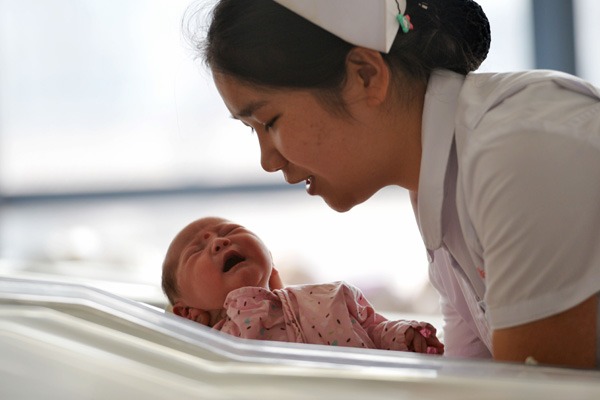Pronatalist policies needed to boost fertility rate


The Economist published an article on May 23, titled "Why paying women to have more babies won't work", questioning the effectiveness of pronatalist policies in increasing total fertility rates. The article's arguments are misleading and its conclusion is absurd.
The article argues that pronatalist policies are ineffective in case of professional women, citing evidence that university-educated women only delay childbearing slightly, and have roughly the same number of children as their peers did a generation ago. This argument is unfounded.
To determine whether a policy is effective or not, one needs to compare the fertility status of women who benefited from the policy with those who did not. In the absence of micro-level data, one may compare fertility rates of different countries giving different levels of subsidies. In this regard, data from Europe show a 1 percent increase in family welfare expenditure relative to GDP corresponds to roughly a 0.1 increase in fertility rates.
The article says that Sweden offers very generous subsidies, yet its total fertility rate is only 1.7. However, Sweden's fertility is among the highest in Europe, suggesting that its policy does work but is simply inadequate to raise the fertility to the replacement level of 2.1.
The article's main argument against fertility subsidies is that they would encourage younger and poorer women to have more babies, thus rolling back decades of efforts to curb unwanted teenage pregnancy. However, in an era of increasingly delayed childbearing and falling fertility rates, it is wrong to be fearful of early childbearing and more births.
Beneficial for both mother and child
The mean age of women at the birth of first child in OECD countries rose from 26.4 years in 2000 to 29.4 years in 2020. Bearing children between the ages of 20 and 30 is medically beneficial for both mother and child. And delayed childbearing is linked to reduced fertility, increased risks of pregnancy complications, and higher rates of congenital abnormalities in the fetus.
In the past, the problem of childbirth among younger and poorer women was largely due to low income. These women are having much fewer children than they did before, indicating they are unwilling to push themselves and their children into poverty and an unhealthy environment. Subsidies simply give them more options, and can help improve their as well as their children's well-being.
With the populations of many countries shrinking faster than ever, raising children for the sustainability of society may not be as meaningless as engaging in jobs that could be easily replaced by artificial intelligence. Therefore, those women giving more births deserve cash rewards.
The Economist's article claims that pronatalist policies cause more problems than they are designed to solve. This is absurd. Subsidies may be the cost taxpayers pay for the sustainability of society, but they benefit the recipients, representing a redistribution of economic wealth in favor of those raising children and contributing to the sustainability of the economy. Parents invest time and resources in raising children who, upon reaching adulthood, help sustain the economy through their consumption and labor, and provide direct support for society by paying taxes.
Based on this grossly exaggerated cost-per-extra-baby argument, the article says that only a tiny number of citizens are productive enough to generate fiscal benefits to offset that kind of money. But even if that were true, it does not mean subsidies are unworthy. Only a small fraction of venture capital projects succeed, yet the profits from the successful ones can offset the losses from the rest, leading to net gains.
Similarly, the contribution of individuals to society follows a power law distribution principle, where a very small number of outstanding talents may generate a disproportionately large percentage of social wealth, and nurturing such talents requires a large population base.
Therefore, the validity of an investment can be better judged by calculating whether the average return exceeds the average cost. For example, in 2023, France's per capita GDP was $44,400, with taxes and social security accounting for 48 percent of GDP. Given the country's average life expectancy of 83 years, the lifetime cumulative contribution of tax and social security by an average French citizen would amount to $1.77 million, far exceeding the average childbearing subsidies of $154,000.
While this comparison is not entirely fair because citizens also enjoy the welfare and conveniences that come with taxes and social security, it is undeniable that the overall value of an individual to society is positive. Over the past centuries, societies across the world have become increasingly prosperous despite the growing global population, which suggests, at least in economic terms, the average contribution of a person to society outweighs the burden he/she creates.
East Asia needs to raise fertility rates
The article admits that fertility rates are falling nearly everywhere and populations are declining in many advanced economies. According to the current fertility rate, an average woman in a high-income country will have 1.6 children, meaning that each generation will be smaller than the one before it.
While Tesla CEO Elon Musk has warned that this demographic trend of declining population threatens civilization itself, the article dismisses the warning as ridiculous without giving any reason. If total fertility rates remain substantially below the replacement level, a population will shrink rapidly until it vanishes.
With the replacement level at 2.1, maintaining a fertility rate of 1.6 in high-income countries means the population will ultimately shrink at a rate of one birth for every two deaths. And a fertility rate of 0.7, as in the case of South Korea, means the population will shrink at a rate of one birth for every 15 deaths. If this trend is not a threat to civilization, what is?
Many believe that such extrapolation is baseless as fertility rates will not remain so low forever, but this is mere wishful thinking. Low fertility rates tend to be self-reinforcing in nature. While the marginal cost of child-rearing will increase with the shrinking of family size, suppression of the intent of the younger generation to have babies, persistently low fertility rates will worsen population aging problems, resulting in heavier burden on families and society at large for taking care of elderly people. This will strain the time and financial resources that could otherwise be directed toward child-rearing. Without policy intervention to break these self-reinforcing cycles, the total fertility rates are more likely to decline.
To sustain the human civilization and to ensure the well-being of the current population, it is imperative to take measures to increase the total fertility rates to the replacement level, the sooner, the better. The crux of the low fertility issue is the misalignment of incentives; families and individuals bear the costs of raising children while the broader society reaps the benefits.
In an agrarian society, children contribute directly to their parents' livelihood when they grow up. However, in an industrialized society, especially with a pension system in place, the economic benefits that children provide for their parents mostly materialize at the societal level, rather than within the family unit. Specifically, the value of pensions and healthcare for the elderly stems from the goods and services the working-age population provides. With fewer young people in society, the possibility of pension savings redeeming goods and services is limited.
Moreover, The Economist's article emphasizes that the decision to have children is personal. This is certainly right on a micro level. But on a macro level, if no one in a country wants to have children, its economy will collapse and society will be doomed. So there must be an effective incentive mechanism to ensure that the fertility rate returns to the replacement level.
Currently, the East Asian region has some of the world's lowest fertility rates, which are far below the average of 1.6 for high-income countries. Hence, countries in this region such as China, Japan and South Korea need to give fertility subsidies much more than the rest of the world.
James Liang is chairman of the executive board of Trip.com Group and a professor at Guanghua School of Management, Peking University; and Wenzheng Huang is CEO of YuWa Population Research and a specially appointed researcher at the Center for China & Globalization. The views don't necessarily reflect those of China Daily.
If you have a specific expertise, or would like to share your thought about our stories, then send us your writings at opinion@chinadaily.com.cn, and comment@chinadaily.com.cn.

































